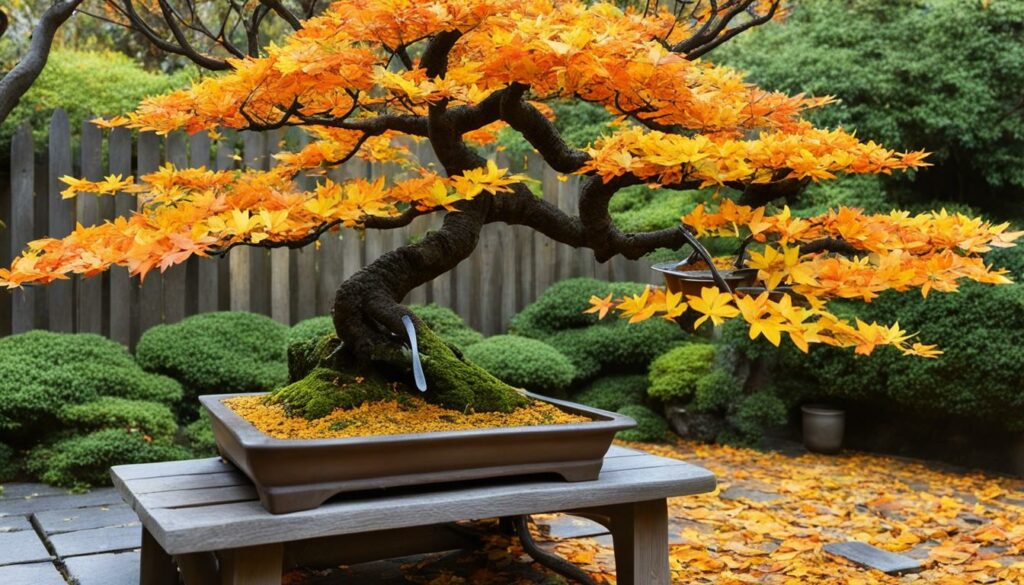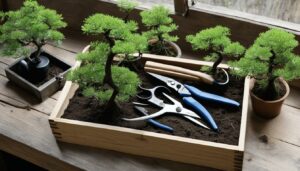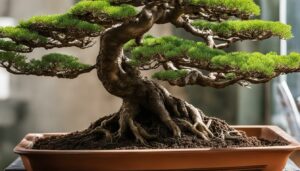As you cultivate the timeless art of bonsai, understanding Bonsai Seasonal Care becomes pivotal in nurturing these miniaturized marvels. In each changing season, your commitment to year-round care and diligent bonsai maintenance is tested. This guide is your ally in deciphering the seasonal whispers of your bonsai, providing you with expert Seasonal tips to keep your bonsai flourishing. Embrace the nuanced rhythm of nature’s cycles, and watch your bonsai thrive as a living sculpture, adapting and growing through the seasons.
From the awakening buds of spring to the restful silence of winter, each period demands specific attention and care. With dedication and this comprehensive seasonal care guide, you will be equipped to anticipate your bonsai’s needs, creating a harmonious dance with the seasonal ballet of growth and dormancy. Gear up to witness the transformation of your bonsai, as it tells the story of the seasons in its miniature tableau.
Key Takeaways
- Grasp the essentials of bonsai maintenance aligned with the shifting moods of the seasons.
- Implement tailored Seasonal tips to enhance the health and visual appeal of your bonsai.
- Adapt year-round care practices to meet the unique requirements of each season.
- Anticipate the needs of your bonsai with a proactive approach to maintenance.
- Experience the rewards of a well-cared-for bonsai as it mirrors the beauty of the changing seasons.
Understanding the Basics of Bonsai Maintenance
Embarking on the journey of bonsai maintenance means embracing a commitment to year-round care. Beyond a mere hobby, nurturing these miniature marvels requires patience, precision, and a thorough understanding of how climate impacts their well-being. To ensure the prosperity of your bonsai, it’s vital to stay vigilant and responsive to the subtle cues they offer regarding their health and needs.
The Importance of Monitoring Bonsai Health Year-Round
As seasons change, so do the conditions that affect the growth and vitality of your bonsai. It’s not just about occasional watering and feeding; year-round vigilance is crucial. Regular monitoring can aid in the early detection of issues, which is essential for the proactive prevention of stress and disease. Whether facing a scorching summer or a frosty winter, your bonsai relies on you to interpret its needs and adjust care accordingly.
Recognizing the Signs of a Healthy Bonsai
A bonsai in peak condition is a sight to behold. Its foliage should be robust and vibrant, a clear indicator of its flourishing state. Sturdy branches and well-draining soil are other signs of robust health. Observing the nuances of leaf coloration, texture, and growth patterns can serve as a direct communication from your bonsai, teaching you to recognize its state and act when necessary. At its core, recognizing health in a bonsai is about harmonizing with the rhythm of nature, responding to your tree’s lifecycle, and the external environment it resides in.
Spring Awakening: Revitalizing Your Bonsai
With the blooming of flowers and the warming air, spring heralds a time of renewal and growth, making it a pivotal period for bonsai maintenance. This is when your bonsai shakes off the dormancy of winter and prepares for a season of vigorous growth. To help your bonsai thrive, it’s essential to employ effective pruning techniques, reevaluate watering schedules, and apply smart fertilization strategies. Let’s dive into the specifics to ensure your bonsai enters spring with its best leaf forward.
Pruning Techniques for Spring
Pruning is not merely about shaping; it’s about directing your bonsai’s energy and encouraging new growth. As the sap begins to flow, judicious pruning is critical:
- Timing: Begin pruning before buds swell to give your bonsai a clean start for sprouting.
- Tools: Use sharp, sterile tools to make precise cuts and avoid damaging tender branches.
- Technique: Focus on removing deadwood, crossing branches, and thinning dense areas to enhance sunlight penetration and air circulation.
Remember, pruning is both an art and a science, and the goal is to maintain the tree’s structure while also setting the stage for future growth.
Appropriate Watering After Winter Dormancy
As spring arrives, your bonsai’s watering needs will increase. However, transitioning from the conservative winter watering schedule requires care:
- Moisture Monitoring: Check the soil’s moisture level regularly; it should be slightly damp but not saturated.
- Water Quality: Use room-temperature water, ideally rainwater or filtered tap water to avoid chlorine build-up.
- Watering Methods: Water thoroughly until excess water drains, ensuring the root system is evenly moistened.
Increased daylight and temperatures will drive up the frequency of watering, but always let the soil’s moisture level guide you.
Fertilization Strategies to Kick-Start Growth
To support the vigorous growth common in springtime, proper fertilization of your bonsai is a must. Here’s how to nourish your tree for optimal health:
- Fertilizer Selection: Use a balanced, slow-release fertilizer that provides a steady supply of nutrients.
- Fertilizing Frequency: Begin fertilizing as new growth appears and continue according to the product instructions, usually every four to six weeks.
- Micronutrient Boosts: Ensure your fertilizer includes essential micronutrients like iron and manganese for full-spectrum nutrition.
By customizing your approach based on the specific needs of your bonsai species, you’ll promote a healthy start to the season’s growth spurt.
Thriving in Summer: Bonsai Care During Warm Months
As summer sets in, your bonsai trees require particular attention to cope with the rising temperatures and prolonged daylight. This season demands a blend of seasonal tips and attentive bonsai maintenance to ensure the varying climate conditions don’t hinder the health and aesthetics of your miniature trees.
Sun Protection: During summer, the intensity of sunlight increases. It’s essential to position your bonsai in a way that it receives adequate morning light but stays shielded from the harsh midday sun. Creating a partially shaded area can mitigate the risk of leaf scorching.
Humidity Control: Humidity plays a crucial role in the health of your bonsai. As heat increases, so does the rate of transpiration. Employing humidity trays filled with water and pebbles can help create a microclimate with stable moisture levels around your bonsai.
Watering Needs: Warmer weather can dry out soil faster, so monitoring moisture levels becomes imperative. Depending on your climate, you might need to increase watering frequency. Early morning or late afternoon is the best time to water, reducing evaporation and making the most of each watering session.
| Summer Bonsai Care Aspect | Action Items | Benefits |
|---|---|---|
| Sun Exposure | Provide shade during peak sun hours | Prevents leaf burn and overheating |
| Humidity Levels | Use humidity trays; mist leaves regularly | Keeps foliage hydrated and healthy |
| Watering Schedule | Adjust frequency; water in cooler hours | Ensures deep soil moisture without waterlogging |
| Soil Condition | Check for adequate drainage | Prevents root rot from excessive moisture |
Remember, the key to successful summer bonsai care lies in observation and adaptation. Keep a close eye on your trees, and don’t hesitate to adjust your care routine to align with the current needs of your bonsai as they respond to summer’s challenges.
Bonsai Seasonal Care: Transitioning into Fall
As the vibrant colors of fall herald the approach of cooler days, it is essential for bonsai enthusiasts to adapt their maintenance routine in preparation for the pending winter. Seasonal tips guide you through the gradual shift in your bonsai care to protect these living art pieces. Understanding the nuances of year-round care is critical for sustaining the health and beauty of your bonsai trees during this transitional period.
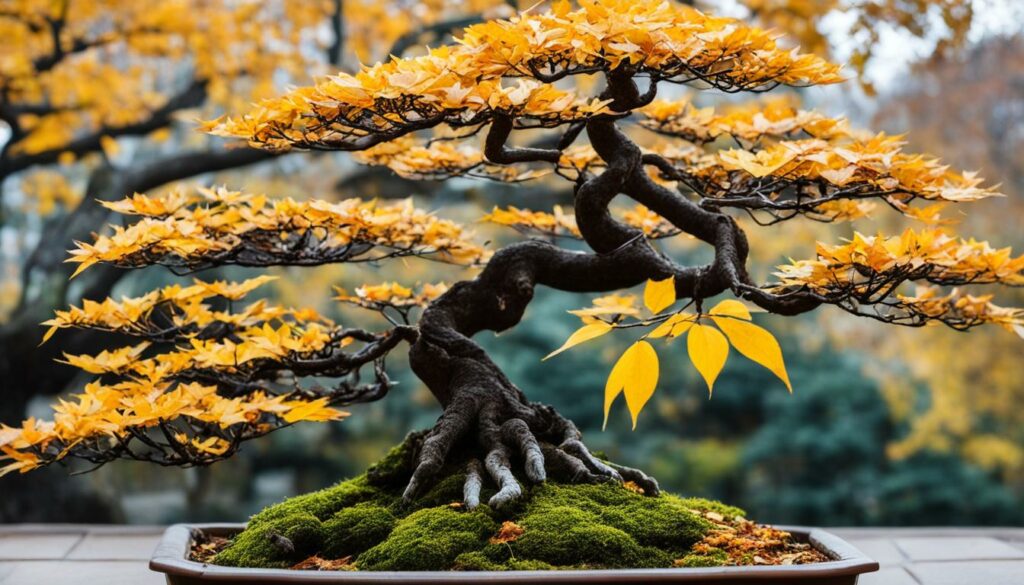
The drop in temperature and shortening days impacts the growth and metabolic rate of your bonsai. To cater to these changes, begin by modifying your feeding schedule. A reduction in fertilization is advised as your bonsai’s growth slows, preparing for dormancy. This subtle adjustment supports the natural cycle of the tree without overwhelming it with unnecessary nutrients.
Recognizing the signs of your bonsai entering dormancy is also essential. Look for reduced growth activity, and the shedding of leaves for deciduous varieties. At this juncture, it’s important to bonsai maintenance practices that will safeguard your trees from early frosts.
Protect your bonsai by moving it to a sheltered spot. If you’re expecting frost, consider a temporary covering overnight or whenever temperatures plunge.
With these seasonal tips, you can rest assured that your bonsai will receive the utmost care as it prepares for winter. Adjusting care during fall not only enhances the current beauty of your bonsai but also sets the stage for a flourishing return come spring.
- Gradually reduce fertilizer to match the tree’s reduced needs.
- Monitor water requirements as cooler weather can slow soil drying.
- Provide protection from early frosts to prevent damage.
- Prepare for the relocation of tender species to indoor settings.
By tending to these considerations, you’re well-equipped to ensure the longevity and vitality of your bonsai through the dynamic tapestry of the seasons.
Preparing Bonsai Trees for Winter Hibernation
As the exuberance of fall winds down, it’s essential to pivot your bonsai maintenance efforts to focus on preparing bonsai trees for winter. This critical phase ensures your miniature trees are not only preserved but also primed for a robust return in spring. By adjusting your care routine, you can effectively protect bonsai from frost and the myriad challenges winter may present.
Adjusting Watering Habits as Temperatures Drop
One of the heralds of winter is the drop in temperatures, signaling a reduced watering frequency for your bonsai. During this dormancy period, the appetite for water diminishes as growth slows. It’s paramount to monitor the soil’s moisture levels, ensuring they remain on the drier side to prevent root rot – a common pitfall during colder months.
Protecting Bonsai from Frost and Harsh Conditions
While the aesthetic of a bonsai glazed with frost may be enchanting, the reality is that frost can be detrimental. The application of antidesiccant sprays is a proactive measure to shield the foliage from desiccation and frost damage. Additionally, finding the right refuge for your bonsai, be it indoors or within a cold frame, can be the difference between it thriving or merely surviving the winter months.
| Winterization Strategy | Action Steps | Benefits |
|---|---|---|
| Watering Adjustment | Reduce frequency, let the soil approach dryness before watering | Prevents root rot, accommodates dormancy needs |
| Frost Protection | Apply antidesiccant sprays, cover or move trees to shelter | Safeguards against foliage damage, ensure survival through frost |
| Shelter Selection | Choose between indoors, greenhouse, or cold frame based on climate | Offers climate-appropriate protection, maintains temperature stability |
Remember that winter doesn’t have to spell adversity for your bonsai. With the careful implementation of these techniques, you can turn this period into a time of rest and rejuvenation for your miniature tree. Come spring, you’ll be rewarded with the flourishing verdure of your well-pampered bonsai.
Year-Round Bonsai Care: A Checklist for Every Season
Maintaining a bonsai is a delicate blend of art and horticulture – a disciplined practice that requires year-round care. As a bonsai enthusiast, it’s essential to follow seasonal tips to ensure the health and beauty of your miniature trees. Below is a checklist designed to assist with bonsai maintenance throughout the different cycles of the year.
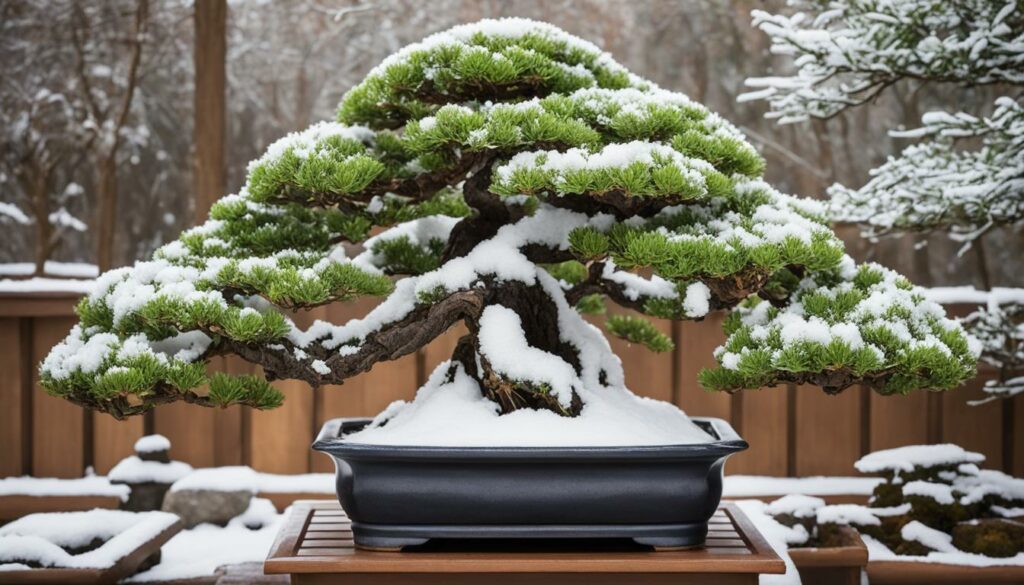
| Season | Watering | Pruning | Feeding | Protection |
|---|---|---|---|---|
| Spring | Increase as the weather warms | Prune to shape and encourage growth | Begin regular feeding with balanced fertilizer | Guard against late frost |
| Summer | Water frequently to combat heat | Light pruning for maintenance | Continue fertilization, but be mindful of heat stress | Provide shade during peak sun |
| Fall | Reduce as temperatures drop | Prune to prepare for dormancy | Taper off feeding to slow growth | Prepare for early frost |
| Winter | Minimal; focus on preventing soil from freezing | Prune sparingly, if at all | Suspend feeding until spring | Protect from frost and harsh conditions |
Beyond this checklist, always be on the lookout for signs of distress and stay informed about specific needs of your bonsai species. Adequate bonsai maintenance transcends a routine—it’s about observance, responsiveness to your tree’s cues, and adapting year-round care practices to sustain the life and vigor of your bonsai through all seasons. Follow these seasonal tips and witness your bonsai thrive.
Indoor vs. Outdoor Bonsai: Seasonal Care Variations
Whether you are nurturing indoor bonsai trees or caring for outdoor bonsai trees, understanding the intricacies of seasonal care is crucial for the health and longevity of these miniature wonders. While both types of bonsai share common care principles, they also have distinct needs that must be met to thrive across the changing seasons.
Understanding the Needs of Indoor Bonsai Trees
Indoor bonsai trees often require more meticulous attention due to the artificial environments in which they live. Light exposure, stable temperatures, and correct humidity levels are essential to mimic the natural conditions these trees would experience outdoors. The lack of seasonal changes inside a home can lead to continuous growth, which necessitates regular monitoring and adjustments in care routines.
Managing Outdoor Bonsai Trees Across Seasons
Outdoor bonsai trees, on the other hand, are subjected to the natural seasonal shifts of their environment. This exposes them to varying weather conditions which can be both beneficial and harsh. Through the icy grips of winter to the sweltering heights of summer, outdoor bonsai trees must receive appropriate care adjustments to ensure their survival and ability to flourish.
| Season | Indoor Bonsai Care | Outdoor Bonsai Care |
|---|---|---|
| Spring | Enhance lighting, begin fertilization, monitor growth | Gradual reintroduction to sunlight, pruning, increased watering |
| Summer | Air conditioning management, consistent watering, avoid overheating | Sun protection, humidity control, diligent watering |
| Fall | Prepare for reduced growth, begin to decrease watering | Pre-winter pruning, mulching, reduce fertilization |
| Winter | Control heat sources, less watering, pest monitoring | Cold protection, limited watering, shelter from frost |
By recognizing the diverse needs of both indoor and outdoor bonsai trees, and applying the right seasonal care, you can ensure that these exquisite trees not only survive but also display their full glory year-round.
Tackling Pests and Diseases: Seasonal Protection Tips
For those of you deeply invested in the art of bonsai, it’s crucial to stay vigilant against the threats posed by pests and diseases throughout the changing seasons. Bonsai seasonal care isn’t just about watering and pruning—protecting your miniature trees from these unwelcome visitors is just as important. Let’s discover how you can identify common problems and implement effective seasonal protection tips to keep your bonsai thriving.
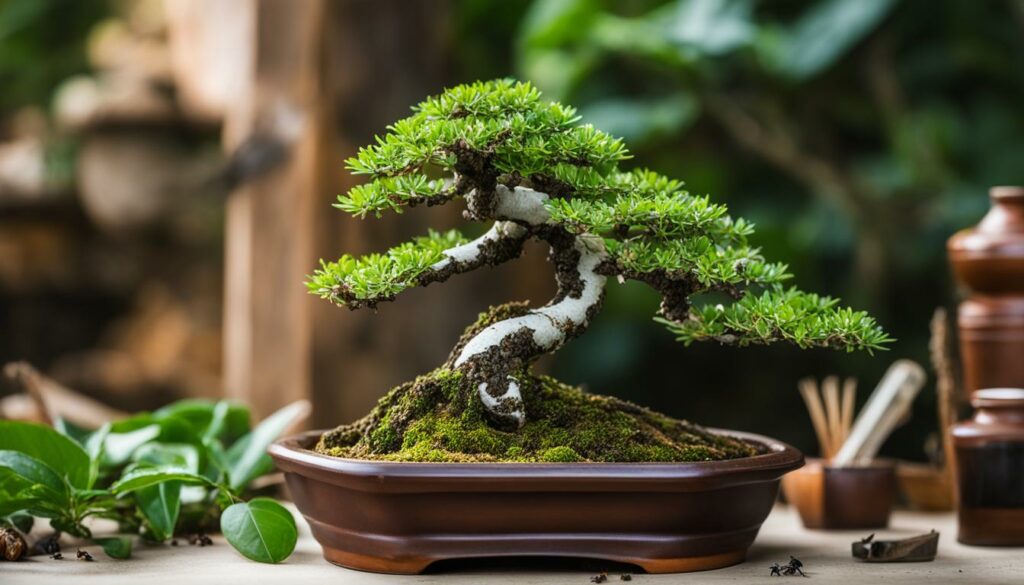
Identifying Common Bonsai Pests and Diseases
Knowledge is power in the fight against bonsai ailments. The first step to protecting your bonsai is recognizing the enemy. Look out for telltale signs such as discolored leaves, sticky residues, or the presence of small insects on your plant.
| Pest/Disease | Symptoms | Seasonal Appearance |
|---|---|---|
| Spider Mites | Yellow, speckled leaves; fine webbing | Common in hot, dry conditions |
| Scale Insects | Brown, hard bumps on stems/leaves; sticky honeydew | Often appear in warmer months |
| Aphids | Clusters of small bugs; misshapen or curled leaves | Spring to summer; peak in warmth |
| Fungal Infections | White, powdery mildew; black/brown leaf spots | High humidity; generally in cooler temperatures |
| Root Rot | Brown, mushy roots; wilting plant | Can occur any time, but higher risk during damp seasons |
Seasonal Treatments to Keep Your Bonsai Healthy
Once you’ve identified the presence of pests or diseases, the next step is to apply suitable treatments. During each season, follow these seasonal protection tips to maintain a healthy bonsai environment:
- Spring: Apply a balanced insecticide as new growth appears to prevent infestations.
- Summer: Increase vigilance for pests; use a miticide during hot spells if spider mites are detected.
- Fall: Clean up any fallen debris around your bonsai to reduce fungal spore spread.
- Winter: Ensure proper air circulation around your bonsai to prevent mold and mildew, especially if brought indoors.
By combining these proactive measures with consistent monitoring for pests and diseases, your bonsai will be better guarded against potential threats. Remember, the key to bonsai seasonal care is a preventative approach, so stay ahead of the curve with these seasonal protection tips.
Soil and Repotting: Seasonal Substrate Care
For any enthusiast of bonsai maintenance, understanding the pivotal role of soil care cannot be overstated. A bonsai’s soil is the foundation of its health, providing the nutrients, aeration, and moisture vital to thrive. Equally crucial is the process of repotting bonsai, which not only refreshes the soil but also promotes a healthy root system. This segment sheds light on the periodical yet essential art of repotting and the selection of the appropriate soil mixtures.
So, why is repotting fundamental? Over time, soil breaks down, reducing aeration and draining capabilities which can lead to root rot and weakened health. Additionally, as the bonsai grows, its roots can become pot-bound, stifling further growth or potentially damaging the root system. Hence, repotting is not merely for aesthetics, but it is a life-giving ritual for your miniature tree.
Contrary to popular belief, repotting does not adhere to a strict schedule; rather, it’s dictated by the species and growth rate of the bonsai. Some fast-growing species may require repotting annually, while older, more mature trees may thrive with less frequent disturbances. It’s essential to repot during the tree’s optimal season, which is generally early spring for most species, as the tree can recover quickly with the forthcoming surge in growth.
Remember, the best soil is the one that caters to your bonsai’s unique needs – think of it as customizing the very ground your miniature tree stands in.
Soil care is about balancing the two S’s: structure and sustenance. Bonsai soil should be loose, well-draining to prevent waterlogging, yet capable of retaining enough moisture to sustain the tree between waterings. It should also have a healthy complement of organic and inorganic materials, providing nutrients while promoting good soil structure.
Opting for a soil mixture specific to your bonsai’s needs can seem daunting, but here’s a pro tip: blends of akadama, pumice, and lava rock are commonly used mixtures that provide an excellent balance for many varieties. Occasionally, adding organic components like pine bark or composted bark can introduce beneficial microorganisms and additional nutrients.
As you embark on repotting, take notice of the following critical steps:
- Gently remove the bonsai from its current pot, taking care not to damage the sensitive roots.
- Prune away any dead or overly long roots, fostering new growth and better nutrient absorption.
- Select a pot that not only fits the tree’s size but also complements its design.
- Position the bonsai in the fresh soil mixture with care, ensuring it has the support it needs.
In conclusion, regular soil examination and periodic repotting form an integral part of holistic bonsai maintenance. With proper knowledge and practice, you ensure your bonsai remains as a vibrant, ever-growing testament to the dedication and patience inherent in the art of bonsai.
Climate Considerations in Bonsai Seasonal Care
As you nurture your bonsai, it’s vital to consider the unique regional climate impacts on care routines. The seasonal shifts in your area directly affect your bonsai’s health and require specific attention to detail to ensure flourishing growth and development.
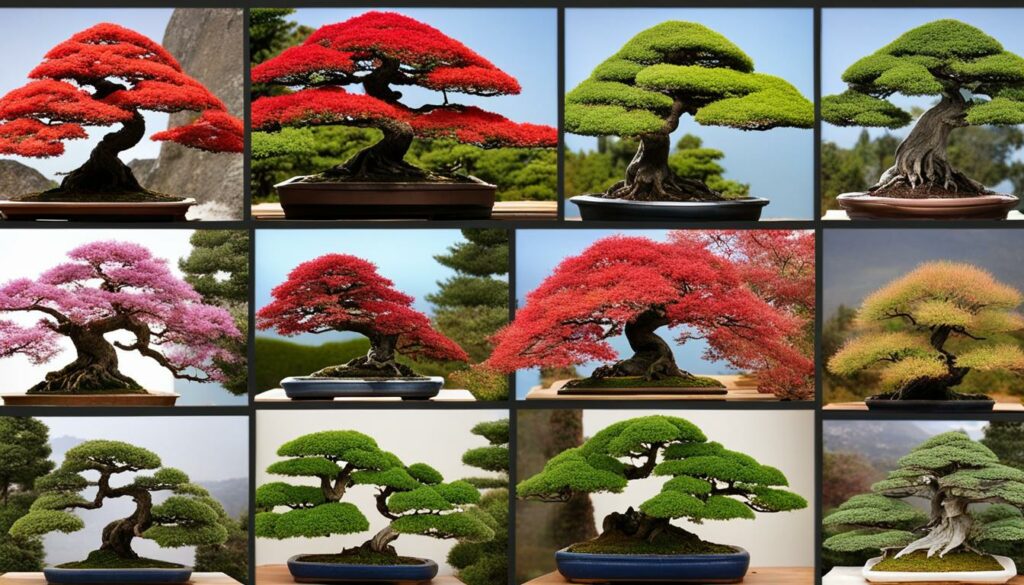
Adjusting Care Techniques Based on Regional Climate
Your approach to bonsai seasonal care should be as varied as the climate you live in. Each region presents its own set of challenges, from the dry heat of arid zones to the high humidity of tropical areas. By tailoring your care techniques accordingly, you’ll provide the best environment for your bonsai to thrive.
| Climate Type | Watering Needs | Sunlight Exposure | Winterizing Steps |
|---|---|---|---|
| Arid | More frequent watering to combat dryness | Partial shade to prevent scorching | Mulching to retain soil moisture |
| Tropical | Consistent moisture with good drainage | Protection from intense midday sun | Minimal; focus on air circulation |
| Temperate | Regular watering but mindful of seasonal rains | Full sun exposure, possibly with some afternoon shade | Frost protection using covers or moving indoors |
| Cold | Reduced watering to prevent root rot | Maximized sunlight during shorter days | Insulation and potential indoor shelter |
Mitigating the Impact of Extreme Weather Conditions
As extreme weather becomes more common, it’s critical to have proactive strategies in place to protect your bonsai. Whether it’s a scorching heatwave, an unexpected frost, or a severe storm, understanding how to swiftly and effectively respond will be key in safeguarding your bonsai’s wellbeing.
- Heatwaves: Increase watering, provide shade, and consider misting to maintain humidity.
- Cold Spells: Employ frost cloths, move trees to a protected area, or provide a heat source to ward off the cold.
- Severe Storms: Secure your bonsai in a sheltered location away from potential wind or debris damage.
With these tips, your bonsai can endure the challenges of extreme weather and continue to grow beautifully in any climate.
Watering Wisdom: Seasonal Hydration for Bonsai Trees
Mastering the art of watering bonsai requires more than just a regular routine; it’s about syncing with the cycles of nature to provide seasonal hydration tailored to your bonsai’s needs. The practice of watering wisdom is integral to the survival and flourishing of your miniature landscape. As each season ushers in a different demand for moisture, understanding when to adjust your watering schedule is as crucial as the watering itself.
Gauging Water Needs Throughout the Seasons
To keep your bonsai in peak condition, you must recognize the varying water requirements as the year progresses. With each season, your bonsai experiences shifts in growth, dormancy, and environmental conditions, all of which influence its thirst for water. Ensure you’re neither overwatering during periods of slow growth nor underwatering when your bonsai is actively developing.
Techniques for Efficient Watering
Employing the right techniques can elevate your bonsai’s health and conserve water in the process. From precision tools to timing, selecting effective methods is essential:
- Use a watering can with a fine nozzle to mimic gentle rainfall, allowing water to slowly seep into the soil without causing erosion or compaction.
- Consider a drip irrigation system for consistent moisture, particularly during the hot and dry spells of summer.
- Water early in the morning or late in the evening to reduce evaporation and ensure that your bonsai has ample time to absorb moisture.
| Season | Hydration Need | Watering Technique | Frequency |
|---|---|---|---|
| Spring | Increase as temperatures rise | Gradual watering | Regularly, as soil begins to dry |
| Summer | High, due to growth and heat | Morning/evening watering | Often, monitoring soil moisture closely |
| Fall | Reduced, as growth slows down | Reduced amounts | Less frequently, allowing soil to partially dry |
| Winter | Minimal, due to dormancy | Gentle watering | Sparingly, only when necessary |
Feeding Your Bonsai: Seasonal Fertilization Strategies
Understanding the nuances of bonsai feeding is crucial to maintaining the health and beauty of your miniature trees. As seasons change, so do the nutritional requirements of your bonsai. Each period of growth demands a tailored approach to ensure your tree not only survives but thrives. Let’s explore the essentials of seasonal fertilization strategies to enhance the vitality of your bonsai throughout the year.
The goal of fertilization is to replenish essential nutrients that are depleted from the soil, especially since bonsai pots hold limited resources. Precision in seasonal fertilization strategies plays a pivotal role; too little and your bonsai may languish, too much and you risk damaging the roots and foliage.
- Spring: A time for growth, requiring nitrogen-rich fertilizers to support the surge in foliage.
- Summer: Balanced fertilizers are key, continuing support for growth while preparing for the upcoming slower growth phases.
- Autumn: Low-nitrogen or ‘winter care’ fertilizers are best, promoting root strength ahead of the dormant season.
- Winter: Typically, a period of rest, with minimal to no feeding required for outdoor bonsai trees. Indoor varieties may still require light feeding, particularly if displaying signs of active growth.
Now, let’s outline an effective fertilization schedule to keep your bonsai at peak condition year-round. Remember, the type of bonsai, its environment, and its stage of life will influence the exact feeding requirements.
| Season | Type of Fertilizer | Frequency |
|---|---|---|
| Spring | High nitrogen content | Every two weeks |
| Summer | Balanced N-P-K ratio | Once a month |
| Autumn | Low nitrogen content | Once a month until late autumn |
| Winter | None or mild formula for indoor bonsai | If required, once every two months |
Optimal bonsai feeding hinges on your attentive care and the specific needs of your bonsai tree. Balancing macronutrients — nitrogen, phosphorous, and potassium — as well as vital micronutrients like calcium and magnesium, is key. An astute bonsai enthusiast observes and adapts to their tree’s responses season by season.
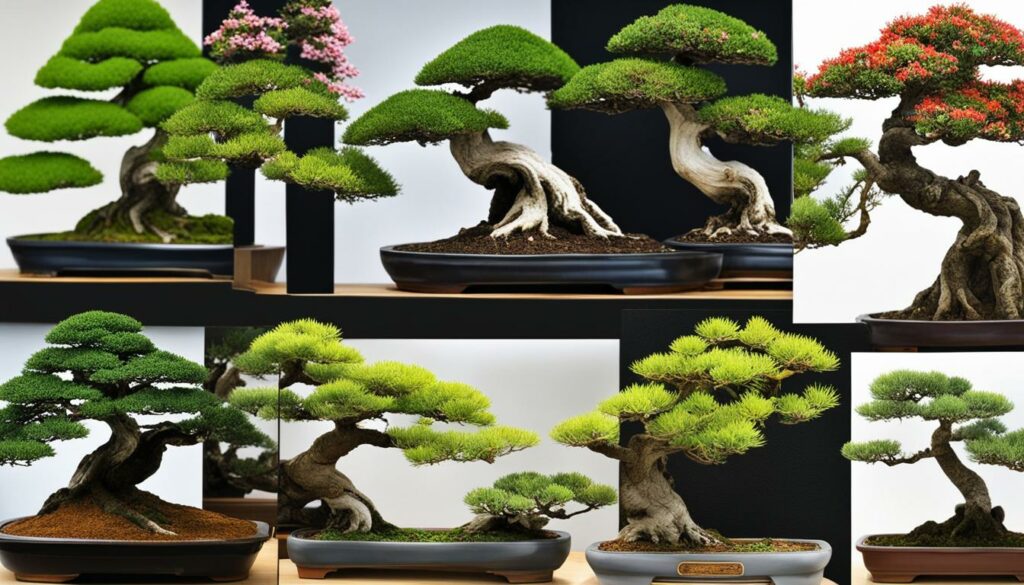
Ultimately, your bonsai’s lush foliage, vibrant colors, and overall health are telltale signs of correct feeding practices. Explore seasonal fertilization strategies with vigilance and care, and your bonsai will reward you with its miniature grandeur all year long.
The Art of Pruning: Seasonal Shaping Techniques
As seasons shift, so do the needs of your bonsai trees. Mastering bonsai pruning is not only about maintaining size but also about encouraging optimal growth and embodying the essence of seasonal shaping techniques. Each cut is a conscious decision in the dialogue between gardener and plant, guiding your bonsai’s story through the seasons.
Spring and Summer Pruning for Optimal Growth
When the warmth of spring unfurls the leaves of your bonsai, it’s time to employ pruning techniques that encourage a flourish of growth and help shape the tree’s structure. During summer, focus on trimming back new growth to refine your bonsai’s design, allowing ample sunlight and air flow to nurture inner foliage. It’s a delicate balance of art and science to achieve the desired appearance while fostering vigor and health.
Winter Pruning to Maintain Structure
Winter is a time of rest for your bonsai, but also a critical period for structural pruning. This dormant phase is ideal for making larger cuts, as the tree can heal without the stress of active growth. Pruning during winter months is essential in preparing your bonsai for the explosive growth of spring, ensuring it retains the desired form and thrives in the upcoming season.
| Season | Objective | Technique | Focus |
|---|---|---|---|
| Spring | Encourage new growth | Light trimming | Removing weak or overcrowded branches |
| Early Summer | Shape and design | Pinching new shoots | Directing growth and enhancing patterns |
| Late Summer | Prepare for next season | Defoliation (where appropriate) | Strengthening tree structure |
| Winter | Maintain structure | Heavy cuts to main branches | Settling the tree’s fundamental form |
Winter Protection: Shielding Your Bonsai from the Cold
As temperatures drop, it’s essential to prioritize winter protection for your bonsai to prevent cold damage. There are several insulating techniques and cold weather storage solutions that can safeguard your delicate trees during the harshest months. Properly prepping your bonsai for winter ensures that they’ll emerge in spring vibrant and healthy.
Insulating Techniques for Potted Bonsai Trees
Protecting your bonsai from frigid weather involves insulating the pot to keep the roots warm. Materials like bubble wrap and wood chips act as excellent insulators. Wrapping the pot in bubble wrap can protect the root system from freeze-thaw cycles, which are often more deadly than a consistent cold. Wood chips, on the other hand, can be used to mulch the soil surface, providing an extra layer of insulation. Additionally, relocating your bonsai to a sheltered area, such as a covered patio or a garden cold frame, can dramatically reduce the exposure to icy winds and frosts.
Cold Weather Storage Options for Bonsai
Finding the right storage option for your bonsai is crucial, and it often depends on your specific climate and the species of bonsai you own. For severe climates, a garage or shed might provide the necessary shelter. Alternatively, for milder climates or cold-sensitive species, a greenhouse or indoor space where temperatures and light can be regulated would be better suited. The key factors of temperature, light, and humidity should be monitored and adjusted to maintain a dormant state without causing the tree stress or dehydration.
Remember, maintaining the delicate balance of dormancy without freezing is the goal of winter protection bonsai practices. Utilizing these insulating techniques and finding appropriate cold weather storage are both paramount to ensure your bonsai’s survival until spring.
Seasonal Bonsai Display: Enhancing Aesthetics All Year
Curating a captivating bonsai display is as much an art form as the cultivation of the bonsai itself. Each season brings a fresh perspective and an opportunity to highlight the unique beauty of these miniature trees. A thoughtful approach to seasonal aesthetics will enhance your bonsai’s presence and ensure that it stands out as a centerpiece in any setting.
As you consider the best practices for bonsai maintenance and presentation, remember that the choice of pot, the height at which the bonsai is displayed, and the selection of background elements can harmonize with seasonal themes to elevate the beauty of your bonsai.
- Spring: Choose bright, lively colors that complement the fresh bloom of your bonsai’s foliage. Display at eye-level against a plain background to draw attention to the new growth.
- Summer: Utilize cool-colored pots that offset the vibrancy of your bonsai’s rich, green leaves. Consider displaying your bonsai slightly lower to give the impression of grounding during the intense heat.
- Fall: Select earth-toned pots that resonate with the changing colors of the leaves. Elevate your display to match the autumn’s gentle descent of leaves.
- Winter: Opt for stark, contrasting colors that accentuate the bare branches or evergreen foliage. Keeping the bonsai on a higher level will remind viewers of the quiet dignity of trees in the winter landscape.
Complementary decorations such as seasonal stones, mosses, and understory plants can be used to underscore your bonsai’s seasonal theme. Below is a table to guide your selection:
| Season | Pot Color | Display Height | Decorative Elements |
|---|---|---|---|
| Spring | Whites, Pastels | Eye-Level | Blossoming plants, Fresh moss |
| Summer | Blues, Greens | Low-Level | Sand, Smooth river rocks |
| Fall | Browns, Oranges | Mid-Level | Autumn leaves, Bark |
| Winter | Blacks, Silvers | High-Level | Evergreen sprigs, Frosted elements |
Incorporating these seasonal tips into your bonsai display will not only enhance the visual appeal but also reflect the natural rhythm of the changing seasons in the environment of your miniature trees. Remember that the ultimate goal is to create a display that celebrates the timeless beauty and meticulous bonsai maintenance that has become synonymous with the art of bonsai.
Conclusion
The rhythmic cycle of the seasons brings with it a symphony of care routines essential for bonsai maintenance. The transition from spring’s rejuvenating touch to summer’s diligent safeguarding, autumn’s thoughtful preparation, and winter’s protective embrace, outlines a year of diligent attention to the well-being of your bonsai trees. Your hands have shaped more than just the branches and leaves; you have fostered an environment where long-term success and the flourishing of nature’s miniature masterpieces can be realized.
Year-In-Review: Seasonal Care and Long-term Success
As we reflect back, it becomes evident that establishing a pattern of conscientious seasonal care is the cornerstone of nurturing a thriving bonsai. Each snip, each watering, and each careful evaluation throughout the changing seasons, contributes to the vitality of these living sculptures. Meticulous care, as detailed in the previous sections, not only preserves the beauty of each bonsai but also fortifies them against the myriad challenges each season may present.
Cultivating a Thriving Bonsai Through Attentive Seasonal Care
The essence of bonsai artistry lies in the detailed and attentive seasonal care you provide. By embracing the ongoing journey of adaptation and learning, you create a legacy that transcends the immediate gratification of aesthetic appeal, crafting a living piece of art that symbolizes resilience and growth. Let each season refine your practices, and in turn, watch as your bonsai collection thrives, becoming a testament to the devotion and care invested over time. Indeed, your pursuit of bonsai perfection is a never-ending conversation with nature, one wherein patience and persistence yield exquisite living rewards.
FAQ
How should I adapt my bonsai care practices with the changing seasons?
You should pay close attention to temperature fluctuations, daylight duration, and humidity levels as these all impact your bonsai’s needs. In spring, focus on pruning and fertilizing to encourage growth. In summer, provide protection from extreme heat and ensure adequate watering. During fall, prepare your bonsai for dormancy by adjusting feeding schedules and protecting against frost. In winter, modify watering habits, and ensure your bonsai is shielded from harsh conditions.
What signs indicate that my bonsai is healthy and thriving?
A healthy bonsai exhibits vibrant, green foliage, sturdy branches, and a strong root system visible at the soil surface. The soil should drain well, and the tree should show new growth during the growing season. Leaves should be free of spots or discolorations, which can indicate pests or disease.
How often should I water my bonsai during the summer months?
In summer, bonsai trees may require more frequent watering due to higher temperatures and increased evaporation. Check the topsoil daily; if it feels dry to the touch, it’s time to water. Always water thoroughly, allowing excess water to drain out, but avoid waterlogging the soil which can lead to root rot.
When is the best time to repot my bonsai, and how often should I do it?
The best time to repot is typically in early spring, right before the growing season begins. However, the frequency of repotting differs among bonsai species. Young, fast-growing trees may need repotting every 2-3 years, while older or slower-growing species might only require it every 4-5 years. Look for signs such as crowded roots or slowed growth as indicators that your bonsai needs a new pot.
How do I protect my bonsai from pests and diseases?
Regular monitoring is essential for early detection of pests and diseases. Keep your bonsai clean and remove any dead leaves or debris. Use organic or chemical treatments as needed, but always according to specific instructions to avoid damage to the tree. Quarantine any new plants before introducing them to your existing collection to prevent the spread of pests or diseases.
What special care should I give to an indoor bonsai as opposed to an outdoor bonsai?
Indoor bonsai trees require careful attention to lighting, ensuring they receive enough but not too much direct sunlight, and maintaining consistent temperature and humidity levels. Outdoor bonsai often need protection from the elements, such as strong winds, frost, or excessive heat, and their watering schedule will depend greatly on weather conditions.
How can I mitigate the impacts of extreme weather on my bonsai?
To protect your bonsai from extreme weather, offer shade during heatwaves, insulate pots during cold snaps, and secure your bonsai in a sheltered location when strong winds or storms are forecasted. Adjust care practices as needed, such as increasing watering during heatwaves or reducing it leading into a cold front.
What should be on my checklist for seasonal bonsai care?
Your checklist should include regular watering per the season’s demand, appropriate fertilization during growth periods, seasonal pruning, disease and pest checks, soil monitoring, and repotting schedules. Also, include seasonal preparations such as frost protection in winter or shading in summer.
Are there different pruning techniques for each season?
Yes, during spring and summer, the focus should be on pruning for shaping and to promote healthy growth. Light pruning can also be done in summer to maintain the tree’s form. Winter is more about structural pruning when the tree is dormant, removing unnecessary branches that don’t fit within the bonsai’s design or hinder its health.
How should I feed my bonsai throughout the year?
Feeding schedules change with the seasons. During the growing season (spring through autumn), use a balanced fertilizer to promote growth. In winter, reduce feeding significantly or stop altogether since the tree is dormant, and the absorption of nutrients is much slower, to prevent root burn from excess fertilizer.
How can I incorporate seasonal aesthetics into my bonsai display?
Match your bonsai’s display to the season by selecting appropriate containers and stands, considering colors and styles that complement the season’s character. For instance, during spring a fresh, vibrant pot color can highlight the new growth, while in autumn, a pot with warm, earthy tones may complement the changing foliage.
